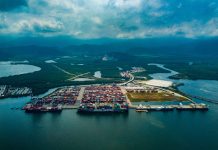
Nineteen rail freight parties signed a partnership agreement on 7 April to launch a foundation, which will be under the leadership of the Port of Rotterdam Authority, aiming to further accelerate the growth of digitisation and data sharing in rail transport sector.
The foundation is estimated to be laid in the next two years, according to a statement, and will be comprised of the following parties from the rail freight sector: Contargo, CTT Rotterdam, Danser, DB Cargo Nederland, DistriRail, European Gateway Services, Haeger & Schmidt Logistics, KombiRail Europe, LTE, Neska Intermodal, Optimodal, Portshuttle, Rail Force One, Raillogix, Rotterdam Rail Feeding, RTB Cargo, and Trimodal Europe, as well as the deep-sea container terminals RWG and Hutchison Ports ECT Rotterdam.
“Due to our sustainability objectives, the Port of Rotterdam Authority together with the Ministry of Infrastructure and Water Management and the logistic parties focus on strong rail transport growth in the next few years,” said Matthijs van Doorn, commercial director at the Port of Rotterdam Authority.
Meanwhile, the growth programme, Rail Connected, has arisen from the Rail Freight Transport Measures Package to promote rail freight transport. The Port of Rotterdam Authority coordinates the programme, which is designed together with the market parties, and it is financed by the Ministry of Infrastructure and Water Management and the Port Authority of Rotterdam.
“A major part of Rail Connected is the further development of the current Notification Container Hinterland Barge service by Portbase, the provider of the Port Community System,” said Iwan van der Wolf, managing director of Portbase, and continued, “As a result, the exchange of information between the chain parties is digitised further, allowing the possibility of reporting trains to the terminal, for instance, and information will be available about the composition of the train.”
Last but not least, Van Dorn stated that the transparency and insights that arise from the digitisation will contribute to improved predictability of rail freight transport as a product, and this will help optimise the use of the railway, the trains, and employees while boosting the growth of rail freight traffic.
“The Rail Connected growth programme is a first, major step to make this possible,” he pointed out.





